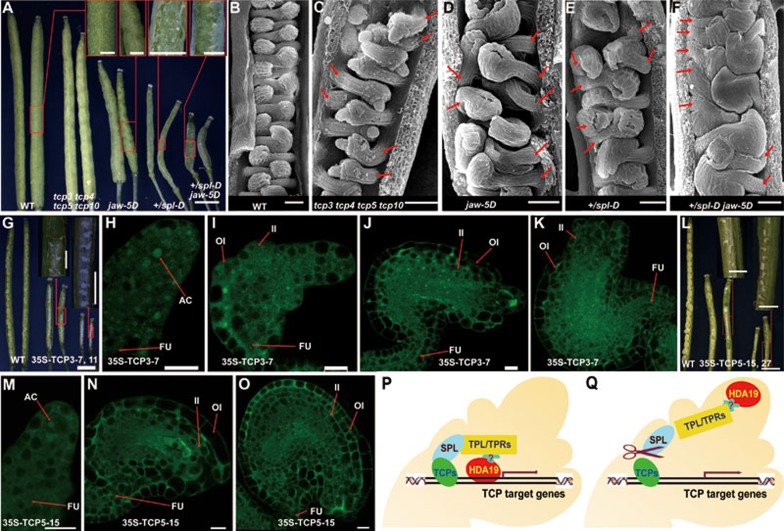Figure 5.
The CIN-like TCPs are implicated in ovule development. (A) The seeds are protruded from siliques from the CIN-like TCP disruption mutants and spl-D. Scale bars, 1 mm and 250 μm in the insets. (B-F) The interdigitated array of ovules was disrupted in the CIN-like TCP disruption mutants and spl-D. The interdigitated array of ovules in young pistil of wild type (B). The abnormal arrays of ovules in tcp3 tcp4 tcp5 tcp10 (C), jaw-5D (D), spl-D (E) and jaw-5D +/spl-D(F). The red arrows indicate the consecutive ovules. Scale bar, 50 μm. (G-K) The TCP3overexpression lines produced aborted ovules. The dissected siliques from wild-type and two 35S-TCP3 plants (G). The ovule of 35S-TCP3 plant produced an archesporial cell (H). No megasporocyte was formed in the ovule (I). No egg cells, central cells, synergid cells and antipodal cells were formed in the ovules (J, K). The integuments of the ovules displayed retarded growth. Scale bars, 1 mm (G) and 250 μm in insets of G, and 10 μm (H-K). (L-O) Overexpression of TCP5 caused aborted ovules similar to those in spl mutants. The dissected siliques showed high ratios of aborted ovules (L). The archesporial cell in the tip of the primordium contained a big nucleus (M). No megasporocytes or megaspores were observed in the ovule (N). The nucellus contained no egg cells, central cells, synergid cells and antipodal cells (O). Scale bars, 1 mm (L) and 250 μm in the insets of L and 10 μm (M-O). AC, Archesporial cell; FU, Funiculus; OI, Outer integument; II, Inner integument. (P, Q) The working model of SPL. (P) In the context of SPL expression, the N-terminus of SPL interacts with the CIN-like TCPs, while the EAR motif at the C-terminus interacts with TPL/TPR co-repressors. The activities of TCPs are modified by the connection with TPL/TPRs. The TCP downstream genes are possibly regulated so that the differentiation of megasporocytes is promoted. (Q) When SPL is inactivated, TPL/TPRs are dissociated from CIN-like TCPs. The excessive activities of TCPs alter the expression of TCP downstream genes and cause abnormal ovule development.

